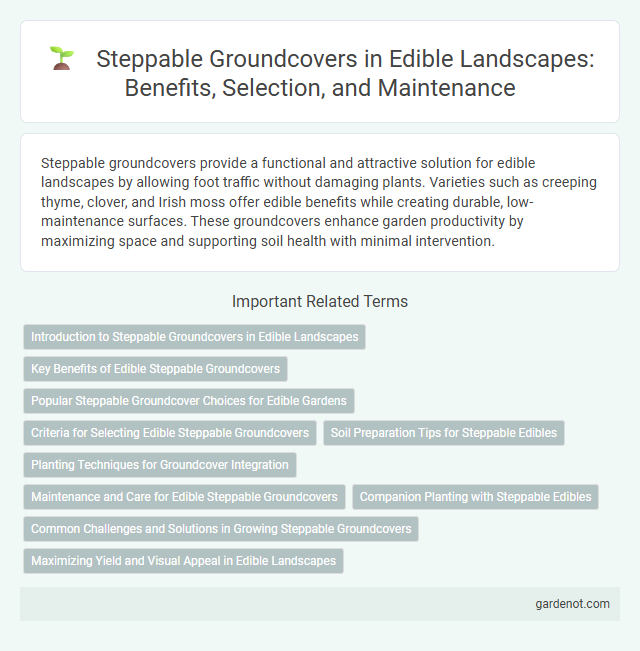Steppable groundcovers provide a functional and attractive solution for edible landscapes by allowing foot traffic without damaging plants. Varieties such as creeping thyme, clover, and Irish moss offer edible benefits while creating durable, low-maintenance surfaces. These groundcovers enhance garden productivity by maximizing space and supporting soil health with minimal intervention.
Introduction to Steppable Groundcovers in Edible Landscapes
Steppable groundcovers in edible landscapes offer a practical and aesthetically pleasing solution to maximize garden space while supporting foot traffic. These low-growing plants, such as creeping thyme and chamomile, are drought-tolerant, hardy, and often aromatic, making them ideal for pathways and between rows of vegetables or fruit bushes. Incorporating steppable groundcovers enhances soil health by reducing erosion, suppressing weeds, and improving moisture retention in edible garden environments.
Key Benefits of Edible Steppable Groundcovers
Edible steppable groundcovers offer a sustainable alternative to traditional lawns by providing nutrient-rich harvests while reducing soil erosion and weed growth. These plants enhance biodiversity and improve soil health through natural nitrogen fixation and organic matter addition. Their low maintenance requirements and drought tolerance contribute to water conservation and lower garden upkeep costs.
Popular Steppable Groundcover Choices for Edible Gardens
Popular steppable groundcover choices for edible gardens include creeping thyme, which is drought-tolerant and produces edible flowers that attract pollinators. Other widely used options are chamomile and oregano, both offering flavorful additions to meals while withstanding foot traffic. These groundcovers enhance garden aesthetics and provide practical benefits by suppressing weeds and conserving soil moisture.
Criteria for Selecting Edible Steppable Groundcovers
Selecting edible steppable groundcovers requires prioritizing durability, low maintenance, and edible value. Ideal candidates like Creeping Thyme and Chamomile must tolerate foot traffic while thriving in local climate conditions and soil types. Nutrient density, rapid growth, and pest resistance further enhance suitability for sustainable, productive edible landscapes.
Soil Preparation Tips for Steppable Edibles
Preparing soil for steppable edible groundcovers involves ensuring well-drained, nutrient-rich soil to support durability under foot traffic and promote healthy growth. Incorporate organic matter such as compost or aged manure to improve soil structure and moisture retention while maintaining a slightly acidic to neutral pH (6.0-7.0) for optimal nutrient availability. Regularly aerate compacted areas and mulch with fine, biodegradable materials to protect roots and reduce soil erosion, enhancing the longevity and productivity of edible pathways.
Planting Techniques for Groundcover Integration
Planting techniques for steppable edible groundcovers emphasize soil preparation, spacing, and layering to ensure durability and growth. Incorporating organic mulch and maintaining consistent moisture aids root establishment and weed suppression. Strategic placement near walkways or low-traffic areas maximizes edible yield while sustaining foot traffic tolerance.
Maintenance and Care for Edible Steppable Groundcovers
Edible steppable groundcovers such as creeping thyme and strawberries require regular weeding and occasional trimming to maintain healthy growth and prevent overcrowding. Consistent watering during dry periods ensures the plants establish strong roots and produce abundant fruit or foliage. Applying organic mulch not only retains soil moisture but also suppresses weeds, enhancing overall plant health and productivity.
Companion Planting with Steppable Edibles
Steppable groundcovers like creeping thyme, chamomile, and oregano create durable, edible walkways that suppress weeds and retain soil moisture. Companion planting these herbs alongside vegetables enhances pest control and improves flavor profiles through natural synergy. This integration maximizes garden productivity by combining functionality and edibility in limited spaces.
Common Challenges and Solutions in Growing Steppable Groundcovers
Steppable groundcovers like creeping thyme and clover face challenges such as soil compaction, uneven growth, and susceptibility to pests. Solutions include selecting drought-tolerant species, improving soil drainage, and applying organic mulch to retain moisture while preventing weed proliferation. Regular maintenance like trimming and aerating ensures durability and aesthetic appeal in edible landscapes.
Maximizing Yield and Visual Appeal in Edible Landscapes
Steppable groundcovers such as creeping thyme, oregano, and chamomile maximize yield by providing edible harvests while creating an attractive, low-maintenance surface. These plants tolerate foot traffic and reduce soil erosion, promoting healthy soil structure and moisture retention essential for thriving edible landscapes. Integrating diverse, flavorful groundcovers enhances both visual appeal and functional productivity across garden pathways and open spaces.
Steppable groundcover Infographic

 gardenot.com
gardenot.com